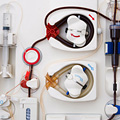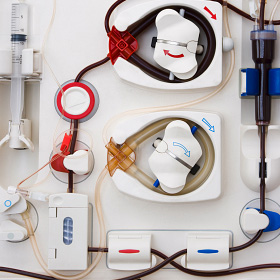
An example of a dialysis machine.
Hemodialysis is a common treatment option for advanced and permanent kidney failure. It involves removing blood from the body and using a machine (dialyzer) to filter harmful wastes from it, which would normally be performed by healthy kidneys. The filtered blood is then returned to the body.
People with chronic kidney disease often start hemodialysis after experiencing a gradual loss of kidney function. You and your doctor should discuss whether hemodialysis is an appropriate treatment option for you.
People who require hemodialysis must have it regularly. You may wish to discuss with your doctor about a specific schedule that would best suit your needs. You may receive hemodialysis at a special dialysis centre, at a hospital dialysis unit, or at home.
Risks and precautionsHemodialysis is usually a straightforward and safe procedure. However, there are some risks of complications or side effects, including:
- air bubble in the blood
- anemia
- bleeding at the site of where blood leaves and re-enters your body (the access point)
- blood clot
- infection at the site of where blood leaves and re-enters your body
- irregular heartbeat
- itchy skin
- low blood pressure
- cramps
- nausea and vomiting
- headache
- sleep disturbances
It is important that you understand all the risks of complications and side effects of the procedure, and what you or your doctor can do to avoid them. Make sure that your doctor is aware of all your concerns.
Some people may experience complications or side effects other than those listed. Check with your doctor if you notice any symptom that worries you after your procedure.
During the testThe treatment usually takes 3 to 5 hours, and you typically need 3 treatments per week. Special training is usually required to have hemodialysis in a dialysis centre and at home. You and your doctor should discuss which schedule and environment best suit your needs.
Before the treatment begins, your dialysis access point will be cleansed, and your weight, blood pressure, pulse, and temperature will be measured. During the treatment, two needles will be inserted into the dialysis access point. Each of the needles are attached to tubes that connect to the dialysis machine (dialyzer), which filters your blood for wastes and returns the filtered blood back to your body.
You may feel nauseous and get stomach cramps during the treatment. Expect to have your blood pressure and heart rate checked several times during the treatment. You may also have your weight taken again after your treatment is complete. Finally, a dressing may be applied to the dialysis access point to help prevent bleeding.
Before the testIt is important that you fully understand what the procedure involves beforehand. Ask your doctor to explain the risks, benefits, and drawbacks of the procedure, and don't be shy to probe further until you are comfortable with your doctor's responses.
Before you can begin your first treatment, your doctor will create an access point (also called a dialysis access) for blood flow in and out of your body. There are various types of access for hemodialysis, including arteriovenous (AV) fistula, AV graft, and central venous catheter.
You and your doctor will decide which one is best for you based on a number of factors, such as how soon and how long you will need hemodialysis treatment. Some people may only need hemodialysis for a short time, although most people with kidney failure will require hemodialysis for the rest of their lives.
If you are taking any prescription or over-the-counter (non-prescription) medications, supplements, or herbal products, make sure you inform your doctor or pharmacist. Ask them whether it is necessary for you to stop taking any of these medications and products before the procedure. It is also important to tell them if you have allergies to certain medications, bandages, latex, or have other medical conditions.
After the testBlood tests will be performed about once a month to monitor how well your hemodialysis is working. You should also have your dialysis access monitored each month to ensure proper blood flow.
When getting hemodialysis, it's very important to keep a healthy diet. Proper fluid and nutrient intake are important factors in improving your results and overall health. If a healthy diet is not part of your hemodialysis treatment plan, you should ask your doctor about working with a dietitian to develop a personalized meal plan to best suit your needs.

An example of a dialysis machine.